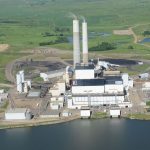A coal power plant in North Dakota wants to build the largest ever carbon recapture facility as a way to try to keep its plant viable. Could the plan really work?
Minnkota Power Cooperative in Grand Forks, North Dakota owns both the plant, the Milton R. Young Station, and the new facility, Project Tundra. Minnkota says its efforts to sequester and recapture waste carbon are motivated both by keeping its plant running and the amount of carbon it can save from reentering the environment.
“To sequester CO₂ from the Young station, Project Tundra will make use of technology similar to that employed at the only two other existing carbon capture and storage (CCS) facilities operating at power plants in the world—Petra Nova in Texas and Boundary Dam in Saskatchewan, Canada,” IEEE Spectrum explains.
How does it work? First, waste CO₂ goes through a “scrubber,” in this case a cooling scrubber that leads into an absorber for amine gas treating. Special chemicals called amines readily bond with CO₂ so it can be filtered out of the rest of the through-flowing gases. Then, the carrying amines are separated from the CO₂. The amines can be reused, and the CO₂ is compressed into a liquid that can be pumped underground for inert storage. What’s left is mostly nitrogen, which already makes up more than three-quarters of our atmosphere.
Reporting on the predecessor Petra Nova plant, the Department of Energy’s Energy Information Administration (EIA) says this process can recover up to 90 percent of CO₂. There are two similar technologies that can work better in different scenarios, and a working version installed in a coal plant can combine elements from each.





